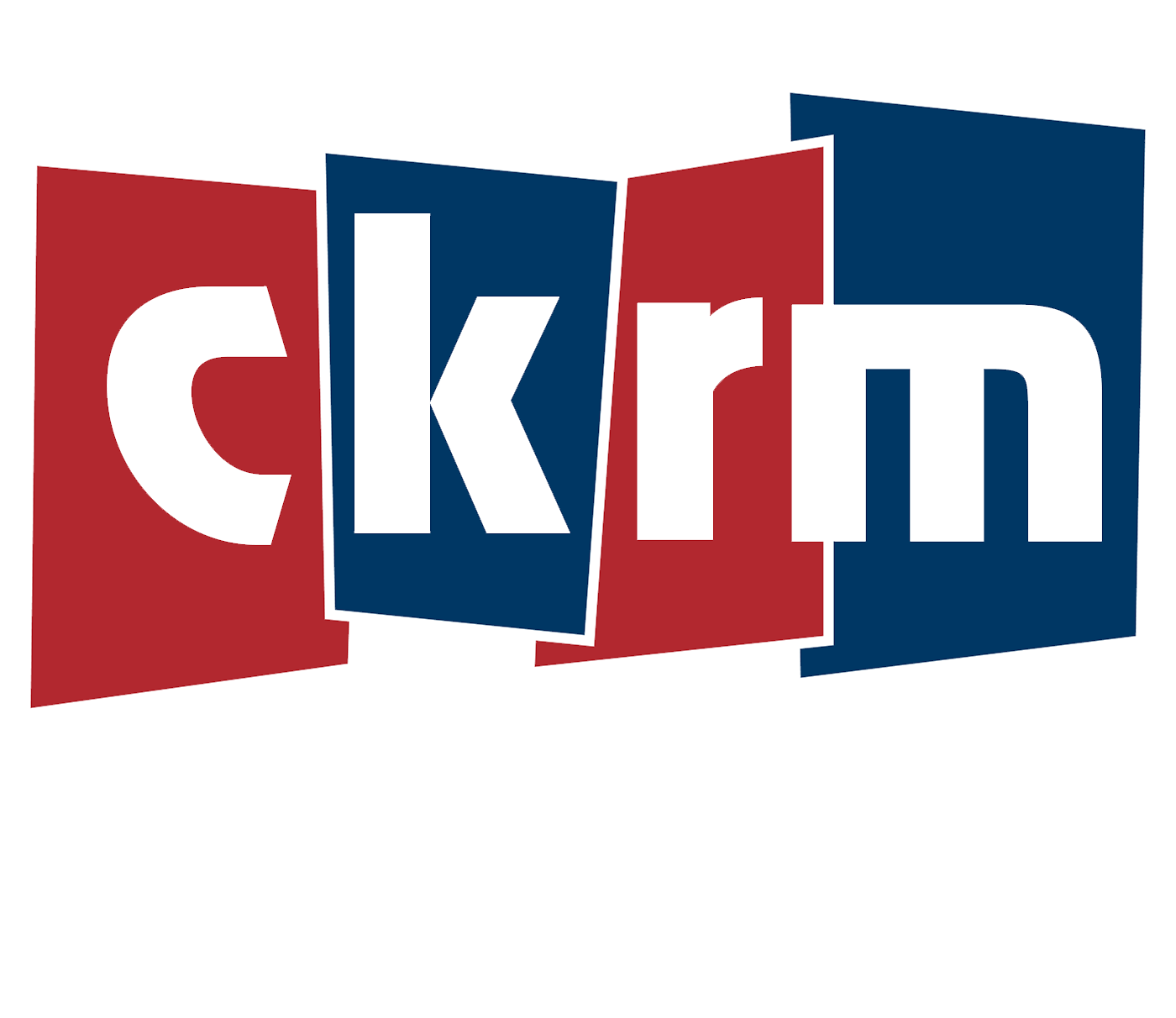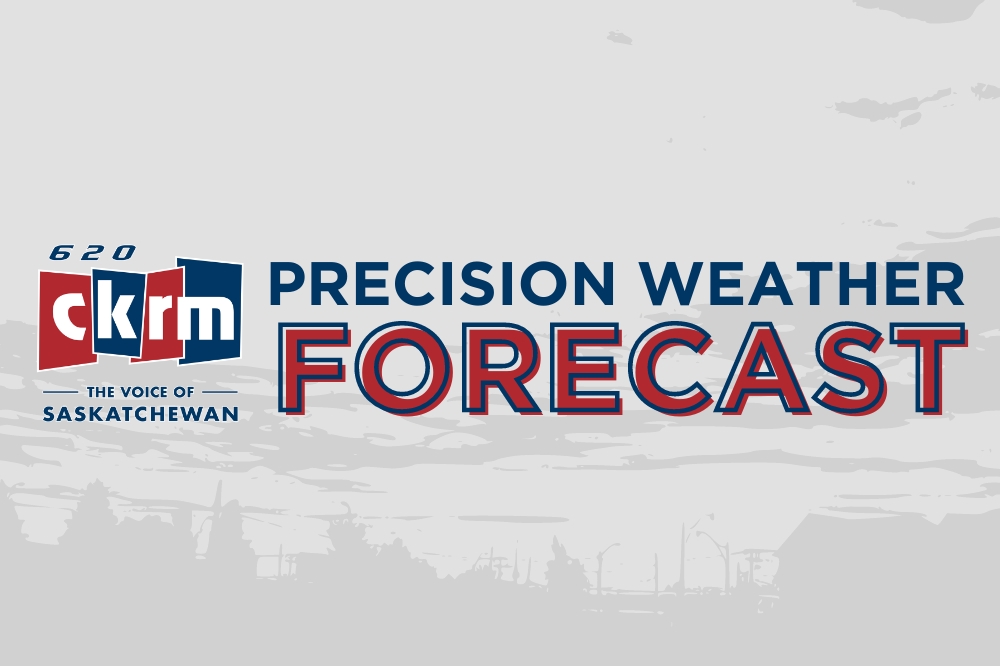The pea leaf weevil (PLW) is a common pest of field peas and faba beans in its native Europe and represents a potential major threat to these crops in Saskatchewan. Although the entire pea-growing area of Saskatchewan is suitable for the establishment of this pest, establishment does not necessarily mean the insect will achieve pest status in a particular location. The degree of damage can vary from year to year, depending on environmental conditions. Dry soils negatively impact eggs and larvae, and therefore reduce population growth and crop damage.
The PLW (Sitona lineatus L.) is a member of the Curculionidae, the weevil family, and the subfamily Entiminae, the broad-nosed weevils. PLW is invasive in North America and was first reported in Canada on Vancouver Island in 1936. It was detected in southern Alberta in 2000. It is currently distributed throughout southern Saskatchewan. PLW range expansion has tended to be more eastward than north. This may be due to failure to survive winter conditions at more northern latitudes.
Identification
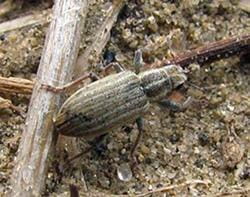
Ministry of Agriculture photo
Adults are 3.6 to 5.4 mm long, slender and greyish-brown. They are distinguished by alternating dark and light-brown stripes that extend down the thorax to the tip of the abdomen. Young (late summer) adult PLW can be distinguished from the sweet clover weevil (Sitona cylindricollis) by these stripes. Adult PLWs lose the scales responsible for this coloration as they age. Distinguishing them from other Sitona at this stage requires microscopic examination.
Eggs are 0.5 mm and yellow-white when first deposited but darken after two to three days.
Larvae are about 0.5 mm when they first hatch and grow to approximately 5.5 mm. There are five larval instars (periods between moults). Larvae are milky-white to yellowish, legless, cylindrical, soft and fleshy with a coppery-brown head capsule; reddish bristles extend from each segment.
Life Cycle
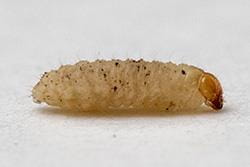
Photo credit: Shelley Barkley
In Saskatchewan, the PLW produces a single generation per year. Adults overwinter in shelterbelts, field margins, alfalfa or other perennial legumes and become active when temperatures exceed 4.5 C. Adult emergence can occur from early to mid-May in warm years. Adult weevils begin feeding on any legume foliage they can find immediately after emerging. They then migrate to the primary host crops (those that will support larvae): peas and faba beans. Generally, they move by walking, but are capable of flying at heights of 10 m once temperatures exceed 12.5 C.
Mating occurs once the primary host is found. Females begin laying eggs within a week of mating. Each female drops one to 24 eggs per day on the soil surface near host plant seedlings. Oviposition generally lasts about 10 days, but can extend to three months. Each female can lay 254 to 1,655 eggs over this period, and densities of eggs can reach 20,000 per square metre. Typically, after about 14 days, eggs hatch and larvae move to nodules, where they chew a tiny hole, enter and feed. All larval instars feed on root nodules that contain Rhizobium leguminosarum.
Larval development typically lasts 30 to 60 days. Mature larvae move into the soil to pupate. Pupation takes about 15 days. New adults start emerging in mid-July and feed on any available legume foliage. Many can stay in place until the crop deteriorates with age and then walk or fly to any green leguminous host plants. Because eggs are laid over time, all life stages can be present on a site.
Host Plants
Field peas and faba beans are the primary hosts for PLW, and there is some evidence of differences in their preference for certain varieties. Adults will also feed on chickpea, red root pigweed, trefoil, lupines, clover, alfalfa, vetches and other perennial legumes, but damage is rarely severe. Larvae cannot complete development on these plants.
Damage
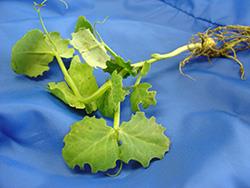
Pea Leaf Weevil on leaf edges.
Ministry of Agriculture photo
Adult PLW consume foliage. U-shaped notches on leaf margins are characteristic of their feeding. Heavy infestations on newly emerged crops can reduce stands.
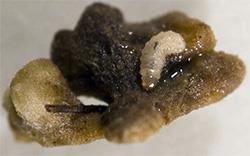
Larval feeding on Rhizobium root nodules reduces nitrogen (N) fixation by the host plant. This is considered the main cause of yield loss. Importantly, soil N can interact with insect feeding and yield effects can be offset in N-rich soils. In fact, control measures may not be required in high-N soils. Although this suggests the importance of N-amendment, results are mixed and the subject of continued research.
Monitoring
Adult weevils fall off plants when disturbed or approached and can be difficult to see. So, characteristic scalloping of seedling leaf margins is the best way to detect the presence of the adults. An aggregation pheromone has been isolated from male PLW and is used to monitor populations. However, no relationship between captured weevils and yields has yet been demonstrated.
Economic Threshold
An economic threshold of 30 per cent of seedlings showing terminal (clam) leaf damage during the second to fifth node stages should be used. This is meant to be an indicator of larval pressure; seedlings recover from all but very heavy adult feeding pressure.
Control
- Chemical – A greenhouse study showed that seed treatment with thiamethoxam reduced egg-laying, adult feeding and, if eggs were added to treated plants early (at the second node stage), larval development. If damage from adult weevils has reached economic threshold before the sixth-node stage, a foliar insecticide can be applied. However, control with foliar applications is not consistent because timing applications to reach adult weevils just before they lay their eggs is difficult. No yield gain was reported through evaluations of foliar insecticides conducted from 2007 to 2010. Insecticides with persistent residues may be more effective in reducing adult numbers during initial spring invasion of the crop, but these insecticides are also more damaging to natural enemy populations.
- Cultural – Soil testing is always important to ensure there are sufficient nutrients for a crop. Having adequate soil nitrogen levels can compensate for larval feeding. The level of soil nitrogen required to compensate for PLW larval damage is the subject of current research.
Winter peas as a trap crop show promise. Peas are the preferred plant for feeding in the spring, so early-planted border strips concentrate adults where chemical control can be applied. - Biological – Although natural enemies of PLW have been investigated in Europe, no native North American parasitoids have been identified at this time. The ground beetle Bembidion quadrimaculatum (a generalist predator) is known to consume pea weevil eggs and is being investigated as a potential biological control agent.
Tips to minimize impact from pea leaf weevil
- Ensure soil nitrogen levels are sufficient for the crop;
- Consider a seed treatment;
- Plant trap crops such as winter peas or early-seeded strips to concentrate adults for control with foliar sprays;
- Maintain crop rotations; and
- Use a foliar insecticide spray as a last resort. PLW eggs and larvae will be unaffected by a foliar insecticide and timing is difficult. Any beneficial insects present will also be negatively affected.
(Government of Saskatchewan news release)
